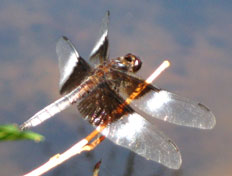Invertebrates
The small, spineless animals that live among us are often overlooked as unimportant, but small is not the equivalent of unimportant. To the contrary, they are often among the most important. They nourish other animals, pollinate plants, help to recycle nutrients once a plant or animal dies, filter water, and act as indicators of the environment's health and integrity.
Mussels
Nine species of freshwater mussels occur in New Hampshire rivers. All of the mussels filter particles out of the water to feed. They thus perform the important job of keeping the river's water clean and clear. Well into the 1990s, the Lamprey supported six species of mussels, an excellent sign of the river's clean water and overall health.
In the summer of 2010, researchers undertook a fresh study of the river's mussels to determine what species were in the river, where they lived, and how well they were doing. The good news was that one species, the eastern elliptio (Elliptio complanata), was thriving almost everywhere in the river.
The bad news was that the other five species are now extremely rare, with only a small handful scattered over distant sites. Their overall condition was not good, with abundant damage to their shells. The researchers found only old mussels, a sign that the mussels are not reproducing and that the outlook for those species is poor.
It was especially distressing to learn that the brook floater mussel (Alasmidonta varicosa) was not doing well. This species in endangered in New Hampshire and much of New England, but it was holding its own in the previous study of the Lamprey from the 1990s.
Although the exact cause of the decline in the Lamprey's mussels is unknown, the researchers believe that high erosion and sedimentation are responsible. Climate change and an increasingly paved landscape have caused several severe floods in recent years. The high flows have eroded and redeposited copious amounts of sand. In some cases, the researchers found areas where rare mussels had been located in the past that are now covered by a foot or more of sand. The shells of many mussels also showed signs of physical abrasion, perhaps the result of fast-moving, suspended sand.
Click for more detailed information from the mussel survey.
Dragonflies & Damselflies
Of all the insects that can be studied, dragonflies and damselflies are some of the best indicators of the health of rivers and ponds. Certain species require clean, clear water, while other species fare well in somewhat polluted water. Dragonflies and damselflies lay their eggs in water, so if evidence of the larvae is found, researchers can match certain water conditions that must have been in effect when the eggs were laid and as the larvae developed.
Research undertaken in the summer of 2011 determined what species occur where on the Lamprey. To view the report, click here. This type of research has also taken place in several locations in New Hampshire. The research is largely non-invasive to the insects, as most specimens consist of discarded larval molts.





